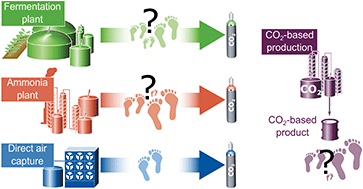The carbon footprint of the carbon feedstock CO2†
Abstract
Capturing and utilizing CO2 as carbon feedstock for chemicals, fuels, or polymers is frequently discussed to replace fossil carbon and thereby help mitigate climate change. Emission reductions by Carbon Capture and Utilization (CCU) depend strongly on the choice of the CO2 source because CO2 sources differ in CO2 concentration and the resulting energy demand for capture. From a climate-change perspective, CO2 should be captured at the CO2 source with the lowest CO2 emissions from capture. However, reported carbon footprints differ widely for CO2 captured, from strongly negative to strongly positive for the same source. The differences are due to methodological ambiguity in the treatment of multifunctionality in current assessment practice. This paper reviews methodological approaches for determining the carbon footprint of captured CO2 as carbon feedstock, and shows why some approaches lead to suboptimal choices of CO2 sources and that increased consistency in life cycle assessment (LCA) studies on CCU is needed. Based on strict application of Life Cycle Assessment (LCA) standards and guidelines, it is shown that substitution should be applied to avoid suboptimal choices of CO2 sources. The resulting methodological recommendations are applied to estimate the carbon footprint of feedstock CO2 for current CO2 sources in Europe and for future CO2 sources in a scenario for a low carbon economy. For all CO2 sources, the cradle-to-gate footprint of captured CO2 is negative ranging from −0.95 to −0.59 kg CO2 eq. per kg of feedstock CO2 today and from −0.99 to −0.98 kg CO2 eq. in a low carbon economy. The carbon footprints of different CO2 sources differ mainly due to their energy demands. The presented assessment method and the carbon footprints of the CO2 feedstocks CO2 provide the basis for future assessments of carbon capture and utilization processes.



 Please wait while we load your content...
Please wait while we load your content...